Key takeaways:
- Understanding audience needs through empathy and active listening can significantly enhance campaign effectiveness.
- Crafting clear, relatable messages and using storytelling alongside visual elements can greatly boost audience engagement.
- Utilizing multi-channel strategies with consistent messaging tailored to each platform helps amplify audience reach and interaction.
- Data-driven insights through analytics and measurement are crucial for adapting campaigns and ensuring they resonate with audience preferences.
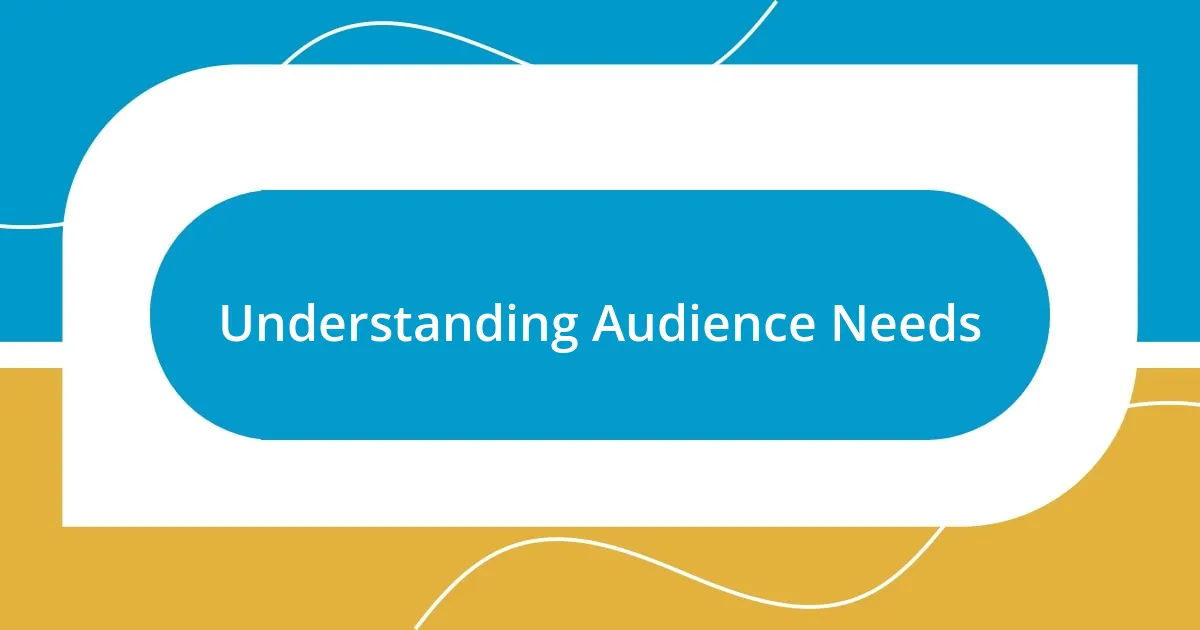
Understanding Audience Needs
Understanding the needs of an audience is crucial for creating effective campaigns. I remember a time when I launched a campaign without thoroughly assessing my audience’s preferences. The result? A lackluster response that taught me a valuable lesson about the importance of audience research. Isn’t it fascinating how a deeper understanding can shape our messaging?
When I conduct surveys or hold focus groups, I often find that listeners appreciate being heard. There’s something powerful about tapping into their thoughts and feelings. In one instance, a heartfelt testimonial from a participant shifted the entire direction of my next campaign, revealing insights I had never previously considered. Isn’t it incredible how people’s stories can inspire and guide our strategies?
Empathy plays an essential role in understanding what resonates with audiences. I’ve learned that putting myself in their shoes—thinking about what they value, what challenges they face—allows me to connect on a deeper level. Have you ever tried to imagine your audience’s daily struggles? It can lead to ideas that feel less like a pitch and more like a conversation.
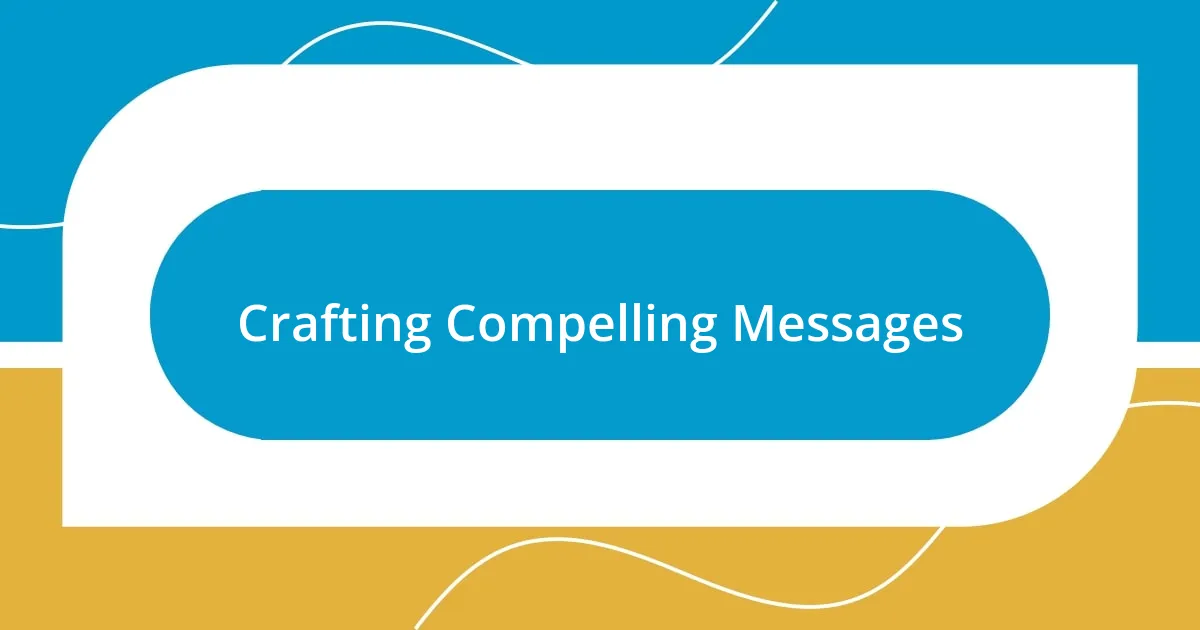
Crafting Compelling Messages
Crafting a compelling message begins with clarity. I often think back to a campaign where I struggled with a convoluted message that left audiences confused. Simplifying the core idea transformed everything—suddenly, engagement soared, and people not only understood the message but felt connected. Clarity creates connection; it’s amazing how straightforward a message can amplify its impact.
I’ve found that storytelling is a powerful tool in message creation. When I told the story of a community member whose life changed due to our initiative, engagement levels skyrocketed. It’s as if the audience could see themselves in that story, making the message resonate on a personal level. Have you ever noticed how relatable stories draw people in? It creates a sense of belonging and sparks genuine interest.
Visual elements are just as significant as words when it comes to crafting messages. I vividly remember using an eye-catching infographic that simplified data into digestible visuals for a campaign. The response was overwhelming! When visuals complement the message, they can evoke emotions and enhance understanding, making it easier for audiences to grasp complex concepts.
| Elements | Impact |
|---|---|
| Clarity | Enhances understanding, reduces confusion |
| Storytelling | Creates emotional connection and relatability |
| Visuals | Boosts engagement and simplifies complex ideas |
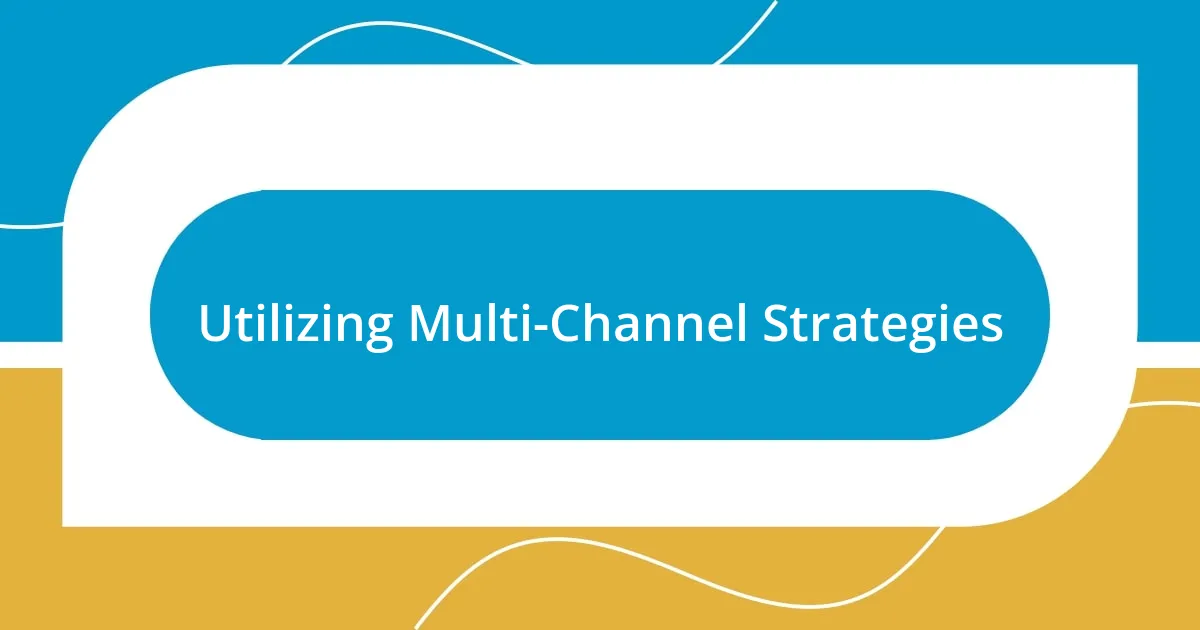
Utilizing Multi-Channel Strategies
Utilizing multi-channel strategies opens up a world of possibilities for reaching audiences effectively. There was a project I worked on where we employed various platforms—social media, email newsletters, and even direct mail. Each channel complemented the others, creating a cohesive experience. I vividly remember a moment when a follower on Instagram mentioned that they had seen our email first, which sparked their interest, but it was the fun video on social media that ultimately motivated them to engage with our campaign. It solidified my belief that when channels work in harmony, they can amplify each other’s strengths.
To truly harness the power of multi-channel strategies, it’s essential to align messaging across platforms while tailoring content to each one’s unique audience. Here’s what I’ve learned:
- Consistency: Keep your core message the same, but adapt the delivery style. For example, casual language on social media, while maintaining a professional tone in emails.
- Segmentation: Group your audience based on their preferred channels. I’ve noticed that certain segments respond better on social media, while others prefer traditional email.
- Engagement Tracking: Use analytics to measure what works best where. When I analyzed engagement rates, I discovered that our email campaigns were performing exceptionally well with our core audience, while social media attracted a younger demographic.
These strategies have not only enriched my understanding of audience behavior but have transformed the way I design campaigns.
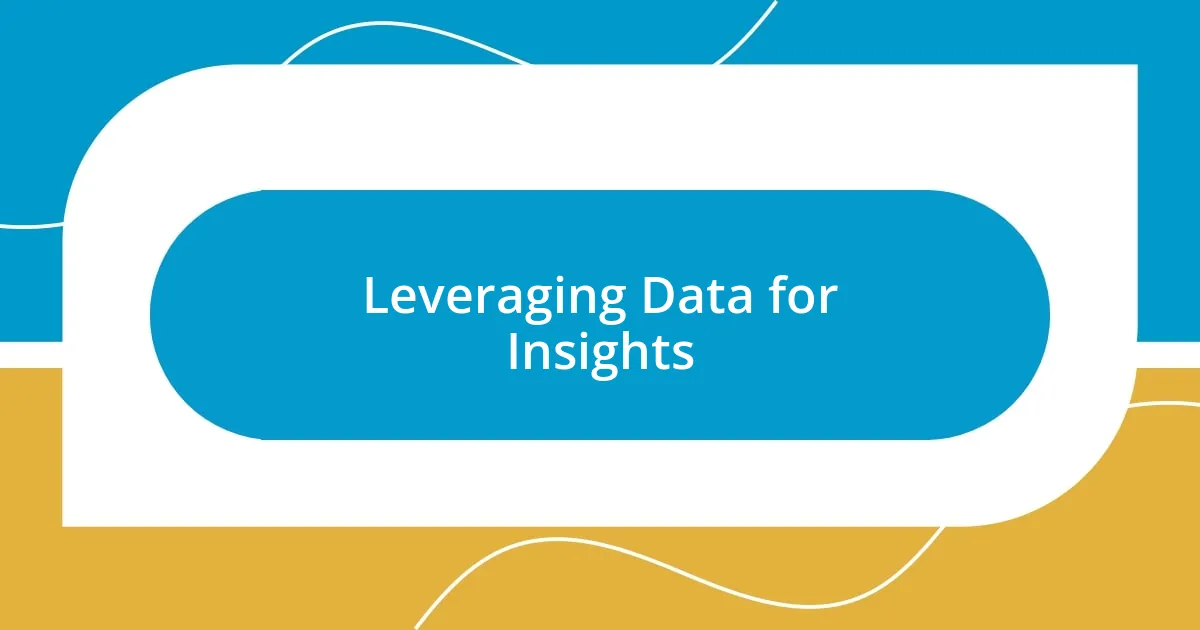
Leveraging Data for Insights
When it comes to leveraging data for insights, I’ve found that numbers can tell an unexpected story. In one campaign, we used analytics to track engagement patterns, and the results were eye-opening. I still remember the moment I discovered that our audience was most active late at night, which totally reshaped how we scheduled our posts. It’s intriguing to think—how often are we missing out by sticking to traditional timing?
I also discovered the power of A/B testing, which allowed me to see firsthand what messages truly resonated. In a recent project, I turned to data to test two different subject lines for our email campaign. What amazed me was the sheer difference in open rates! As the results started to roll in, I couldn’t help but wonder: how many people could we have reached if we had ignored this data-driven approach? Those insights made me realize that understanding audience behavior really is a game changer.
Furthermore, utilizing tools like heat maps gave me a visual representation of user interactions on our website. I clearly remember the thrill of analyzing where visitors clicked the most; it illuminated not just their interests but also areas where we needed improvement. This connection between data and strategy is exhilarating! It makes me ask, aren’t those insights worth celebrating? After all, understanding the nuances of audience engagement propels our campaigns to new heights.
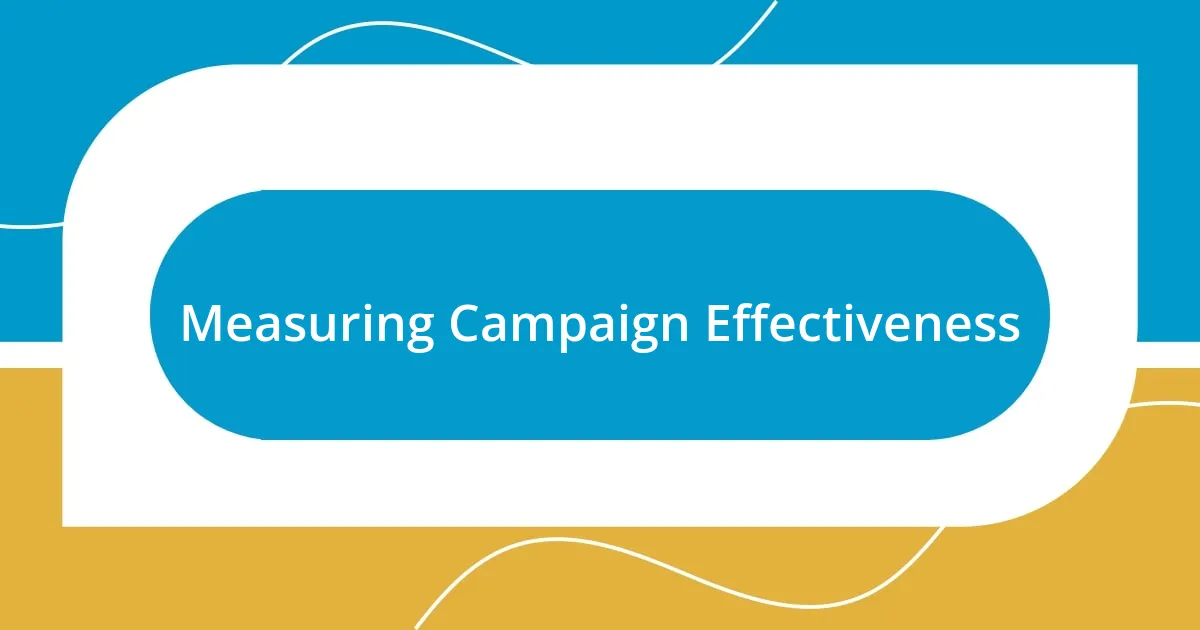
Measuring Campaign Effectiveness
Measuring the effectiveness of a campaign is a critical aspect that often gets overlooked, but I can’t stress enough how vital it is to put this at the forefront of any strategy. Just recently, I wrapped up a project where we meticulously tracked various metrics like click-through rates and conversion figures. I was genuinely surprised to find that a particular social media post generated three times the engagement compared to others, prompting me to rethink not just the content, but also the audience we were targeting. It felt like unearthing a treasure trove of insights that translated directly into actionable strategies.
One of the most revealing moments I encountered was during a post-campaign review. I’ll never forget the day when we pulled together all the data, and what emerged was a clear narrative about our audience’s preferences. For instance, we learned that video content performed significantly better in driving interactions. Seeing those trends brought a flood of ideas for future campaigns, and I became convinced that this feedback loop isn’t just useful — it’s essential. I often ask myself, how many opportunities are we missing if we neglect this step?
What I’ve learned is that combining both qualitative and quantitative data paints a fuller picture. One campaign where we gathered direct feedback from our audience following a series of email blasts revealed that while many loved the visuals, others craved more in-depth information. This balance made me realize that effective measurement isn’t just about crunching numbers; it’s about truly listening to the audience. In what ways can we adapt our approach to ensure we’re not just reaching them, but also resonating with their needs? This ongoing dialogue with our audience is what ultimately elevates any campaign’s success.
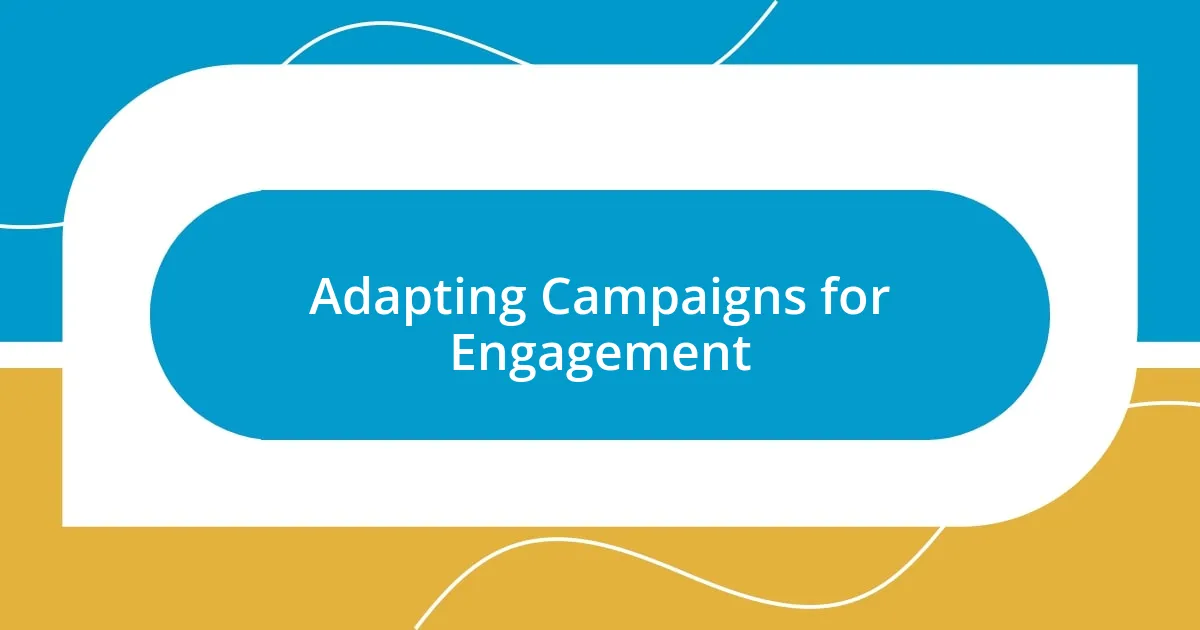
Adapting Campaigns for Engagement
Adapting campaigns for engagement is all about flexibility and responsiveness. I remember a campaign where we initially launched with a static message, only to realize that our audience’s interests had shifted dramatically mid-way. We quickly pivoted, updating the content to reflect current trends, and the results were remarkable—an immediate spike in engagement. Isn’t it fascinating how a simple adjustment can reignite interest?
Another experience comes to mind involving personalized content. We had a diverse audience, and I instinctively felt that a one-size-fits-all approach wouldn’t resonate. By segmenting our audience and tailoring messages to each group’s specific interests, we saw not just higher open rates but also genuine conversations. It made me think—how can we truly connect if we don’t consider the unique perspectives of each group?
Lastly, during a campaign aimed at student engagement, I decided to incorporate user-generated content. Inviting followers to share their experiences not only humanized the brand but also fostered a sense of community. The overwhelming response made me feel that people crave connections more than polished marketing messages. What if we all embraced this idea? Engaging audiences isn’t just about what we present to them, but rather inviting them into the narrative we’re creating.












